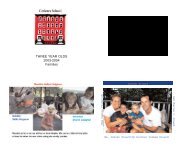SummER INSTITuTE - Visual Studies Workshop
SummER INSTITuTE - Visual Studies Workshop
SummER INSTITuTE - Visual Studies Workshop
- No tags were found...
You also want an ePaper? Increase the reach of your titles
YUMPU automatically turns print PDFs into web optimized ePapers that Google loves.
Doug MancheeFundamentals of DigitalPhotographyJune17–21Jenn LibbyWet Plate CollodionPhotographyJune24–28$550 | This course is available for 3 Undergraduate or 2 Graduate creditsM - F | 9:30AM - 5:00PM | COMPUTER LAB (A2)$550 | This course is available for 3 Undergraduate or 2 Graduate creditsM - F | 9:30AM - 5:00PM | DARKROOMS (A2)This course is an introduction to the fundamentals of digitalphotography. Students will learn to process and modify their filesusing Adobe Photoshop CS. Demonstrations will be given in imagecapture, image processing and output. At the end of the coursestudents will have a thorough understanding of the tools andtechniques necessary to create high-quality digital files and prints.They will be able to employ a variety of techniques using AdobePhotoshop CS to optimize their files for both hard copy (prints) andsoft display (web). Adobe Camera RAW will be introduced allowingstudents to capture the highest-quality image files possible usingdigital SLR cameras. A fundamental knowledge of the basics ofphotography is desirable.Instructor Bio: Doug Manchee is an Associate Professor andProgram Chair of the Advertising Photography program at theRochester Institute of Technology. He has been teaching digitalimaging since 1992. Doug has exhibited his pictures nationallyand internationally. His commercial clients include Adobe Systems,Eastman Kodak, Xerox, Esprit, and many others. He was a LightWork Artist-in-Residence in 2009.Frederick Scott Archer introduced the wet-plate collodionphotographic process in 1851. Its relative simplicity, cost,reproducibility, and versatility led it to supplant the populardaguerreotype. Collodion was used to produce fine-grain, archivalglass negatives, lantern slides, ambrotypes, and tintypes. Theambrotype, like the daguerreotype, is a unique, direct positivephotograph. It is a thin negative on glass that appears as a positivewhen backed with something dark. This class will cover the basicsof the wet-plate collodion process and how to create ambrotypesand aluminotypes. You will use a large format camera to makeambrotypes and aluminotypes, a contemporary version of theferrotype or tintype made using anodized aluminum. Instructionwill cover how to cut and clean glass, pour collodion, sensitizeand process plates, burnish and hand-color final images, apply aprotective varnish, and house your photographs to complete theprocess. Wear old clothing as silver stains are likely. Participantsshould bring their own large format camera and tripod if available.Instructor Bio: Jenn Libby is an installation artist who worksextensively with the wet-plate collodion process and found media.She is the Research Center Coordinator at the <strong>Visual</strong> <strong>Studies</strong><strong>Workshop</strong> in Rochester, NY.Photograph from Picturingthe Archive by Doug MancheeWet-plate collodionphotograph by Jenn LibbyJune24–28




